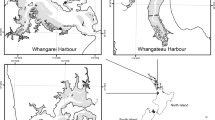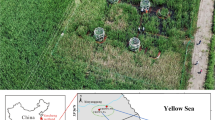Abstract
Past research has examined hurricane impacts on marine communities such as seagrass beds, coral reefs, and mangroves, but studies on how hurricanes affect marsh tidal creeks are lacking despite the important ecological roles that marsh tidal creeks have in coastal ecosystems. Here we report on the impact of Hurricane Ivan, which made landfall on September 16, 2004, on the primary productivity and metabolism of six marsh tidal creeks in the NorthCentral Gulf of Mexico. The hurricane did not seem to have any large, lasting impact on nutrient concentrations, primary productivity, metabolism, and chlorophyll a concentration in the water-column of the marsh tidal creeks. In contrast, the hurricane seemed to largely decrease gross primary productivity, net productivity, and chlorophyll a concentration in the sediment of the marsh tidal creeks. The results observed for Hurricane Ivan were coincident with those observed for four other major storms that made landfall close to the study area during 2005, Tropical Storm Arlene and Hurricanes Cindy, Dennis, and Katrina. However, the apparent negative impact of major storms on the sediment of the marsh tidal creeks did not seem to be long-lived and appeared to be dissipated within a few weeks or months after landfall. This suggests that marsh tidal creeks mostly covered with bare sediment are less disturbed by hurricanes than other types of marine communities populated with bottom-attached and/or more rigid organisms, such as seagrass meadows, coral reefs, and mangroves, where hurricane impacts can be larger and last longer.






Similar content being viewed by others
References
Alongi DM (1998) Coastal ecosystems processes, 1st edn. CRC Press, London
Able KW, Fahay MP (1998) The first year in the life of estuarine fishes in the Middle Atlantic bight, 1st edn. Rutgers University Press. New Brunswick
Armentano TV, Doren RF, Platt WJ, Mullins T (1995) Effects of Hurricane Andrew on coastal and interior forests of Southern Florida: overview and synthesis. J Coast Res 21:111–144
Baillie PW (1986) Oxygenation of intertidal estuarine sediments by benthic microalgal photosynthesis. Estuarine Coast Shelf Sci 22:143–159
Carman KR, Fry B (2002) Small-sample methods for ∂13C and ∂15N analysis of the diets of marsh meiofaunal species using natural-abundance and tracer-addition isotope techniques. Mar Ecol Prog Ser 240:85–92
De Jonge VN, Beusekom JEE (1992) Contribution of resuspended microphytobenthos to total phytoplankton in the Ems Estuary and its possible role for grazers. Neth J Sea Res 30:91–105
Del Giorgio PA, Cole JJ (1998) Bacterioplankton growth efficiency in aquatic systems. Ann Rev Ecol Syst 29:503–541
Doyle TW, Smith TJ III, Robblee MB (1995) Wind damage effects of Hurricane Andrew on mangrove communities along the southwest coast of Florida, USA. J Coast Res 18:159–168
Fourqurean JW, Rutten LM (2004) The impact of Hurricane George on soft-bottom, back reef communities: site- and species-specific effects in south Florida seagrass beds. Bull Mar Sci 75:239–257
Gazeau F, Gentili B, Frankignoulle M, Smith SV, Gattuso JP (2004) The European coastal zone: characterization and first assessment of ecosystem metabolism. Estuarine Coast Shelf Sci 60:673–694
Glynn PW, Almodovar LR, Gonzales JG (1964) Effects of hurricane Edith on marine life in la Parguera, Puerto Rico. Caribb J Sci 4:335–345
Goldfinch AC, Carman KR (2000) Chironomid grazing on benthic microalgae in a Louisiana salt marsh. Estuaries 23:536–547
Guarini JM, Blanchard GF, Gros P, Goleau D, Baker C (2000) Dynamic model of the short-term variability of microphytobenthic biomass on temperate intertidal mudflats. Mar Ecol Prog Ser 195:291–303
Heip CHR, Goosen NK, Herman PMJ, Kromkamp J, Middelburg JJ, Soetaert K, Ansell AD, Gibson RN, Barnes M (1995) Production and consumption of biological particles in temperate tidal estuaries. Oceanogr Mar Biol Ann Rev 33:1–149
Lugo AE, Rogers CS, Nixon SW (2000) Hurricanes, coral reefs and rainforests: resistance, ruin and recovery in the Caribbean. Ambio 29:106–114
Macintyre HL, Geider R, Miller D (1996) Microphytobenthos: the ecological role of the Secret Garden of unvegetated, shallow-water marine habitats. I Distribution, abundance and primary production. Estuaries 19:186–201
McCoy ED, Mushinsky HR, Johnson D, Meshaka WE Jr (1996) Mangrove damage caused by Hurricane Andrew on the southwestern coast of Florida. Bull Mar Sci 59:1–8
Michot TC, Boustany RG, Arrivillaga A, Perez B (2002) Impacts of Hurricane Mitch on water quality and sediments of Lake Izabal, Guatemala: United States Geological Survey, Open file report 03–180, 20 p
Monbet Y (1992) Control of phytoplankton biomass in estuaries: a comparative analysis of microtidal and macrotidal estuaries. Estuaries 15:563–571
Moncreiff CA, Sullivan MJ, Daehnick AE (1992) Primary production dynamics in seagrass beds of Mississippi sound: the contributions of seagrass, epiphytic algae, sand microflora and phytoplankton. Mar Ecol Prog Ser 87:161–171
Pennock JR, Cowan JLW (2001) Analytical instrumentation methods manual. Marine environmental sciences consortium, Technical report 98–003, 69 pp
Pinckney JL, Piceno Y, Lovell CR (1994) Short-term changes in the vertical distribution of benthic microalgal biomass in intertidal muddy sediments. Diatom Res 9:143–153
Pinckney JL, Carman KR, Lumsden SE, Hymel SN (2003) Microalgal-meiofaunal trophic relationships in muddy intertidal estuarine sediments. Aquat Microb Ecol 31:99–108
Poiner IR, Walker DI, Coles RG (1989) Regional studies: seagrasses of tropical Australia, p. 279–303. In: Larkum AWD, McComb JA, Shepherd SA (eds) Biology of seagrasses: a treatise on the biology of seagrasses with special reference to the Australian region. Elsevier, Amsterdam
Preen AR, Lee Long WJ, Coles RG (1995) Flood and cyclone related loss, and partial recovery, of more than 1000 km2 of seagrass in Hervey Bay, Queensland, Australia. Aquat Bot 52:3–17
Quinn GP, Keough MJ (2002) Experimental design and data analysis for biologists. Cambridge University Press, Cambridge, 537 pp
Rizzo WM, Lackey GL, Christian RR (1992) Significance of eutrophic, subtidal sediments to oxygen and nutrient cycling in a temperate estuary. Mar Ecol Prog Ser 86:51–61
Rodriguez RW, Webb RMT, Bush DM (1994) Another look at the impact of Hurricane Hugo on the shelf and coastal resources of Puerto Rico, USA. J Coast Res 10:278–296
Shoaf WT, Lium BW (1976) Improved extraction of chlorophyll a and b from algae using dimethyl sulfoxide. Limnol Oceanogr 21:926–928
Smith TJ III, Robblee MB, Wanless HR, Doyle TW (1994) Mangroves, hurricanes and lightning strikes. Bioscience 44:256–262
Stout JP (1984) The ecology of irregularly flooded salt marshes of the northeastern Gulf of Mexico: a community profile. US Fish and Wildlife Service, Biological Report 85 (7.1) Washington DC
Strickland JDH, Parsons TR (1972) A practical handbook of seawater analysis. Bull Fish Res Board Canada 167:1–310
Stutes AL, Cebrian J, Corcoran AA (2006) Effects of nutrient enrichment and shading on sediment primary production and metabolism in eutrophic estuaries. Mar Ecol Prog Ser 312:29–43
Sullivan MJ, Moncreiff CA (1988) Primary production of edaphic algal communities in a Mississippi salt marsh. J Phycol 24:49–58
Sullivan MJ, Moncreiff CA (1990) Edaphic algae are an important component of salt marsh food-webs: evidence from multiple stable isotope analyses. Mar Ecol Prog Ser 62:149–159
Sundbäck K., Enoksson V, Graneli W, Petterson K (1991) Influence of sublittoral microphytobenthos on the oxygen and nutrient flux between sediment and water: a laboratory continuous-flow study. Mar Ecol Prog Ser 74:263–279
Thistle D (1981) Natural physical disturbances and communities of marine soft bottoms. Mar Ecol Prog Ser 6:223–228
Tilmant JT, curry RW, Jones RD, Szmant A, Zieman JC, Flora M, Robblee MB, Smith D, Snow RW, Wanless H (1994) Hurricane Andrew’s effect on marine resources. Bioscience 44:230–237
Tobias CR, Cieri M, Peterson BJ, Deegan LA, Vallino J, Hughes J (2003a) Processing watershed-derived nitrogen in a well-flushed New England estuary. Limnol Oceanogr 48:1766–1778
Tobias CR, Giblin A, McClelland J, Tucker J, Peterson B (2003b) Sediment DIN fluxes and preferential recycling of benthic microalgal nitrogen in a shallow macrotidal estuary. Mar Ecol Prog Ser 257:25–36
Turpin RK, Bortone SA (2002) Pre- and post-hurricane assessment of artificial reefs: evidence for potential use as refugia in a fishery management strategy. ICES J Mar Sci (supplement) 59:S74–S82
Underwood GJC, Paterson DM, Parkes RJ (1995) The measurement of microbial carbohydrate exopolymers from intertidal sediments. Limnol Oceanogr 40:1243–1253
Valiela I, Peckol P, D’avanzo C, Kremer J, Hersh D, Foreman K, Lajtha K, Seely B, Geyer WR, Isaji T, Crawford R (1998) Ecological effects of major storms on coastal watersheds and coastal waters: Hurricane Bob on Cape Cod. J Coast Res 14:218–238
Valiela I, Cole ML, Mcclelland J, Hauxwell J, Cebrian J, Joye S (2000a) Role of salt marshes as part of coastal landscapes, p. 23–38. In: Weinstein MP, Kreeger DA (eds) Concepts and controversies in tidal marsh ecology. Kluwer Academic Publishers, Dordrecht, The Netherlands
Valiela I, Tomasky G, Hauxwell J, Cole ML, Cebrian J, Kroeger KD (2000b) Operationalizing sustainability: management and risk assessment of land-derived nitrogen loads to estuaries. Ecol Appl 10:1006–1023
van Tussenbroek BI (1994) Aspects of the reproductive ecology of Thalassia testudinum in Puerto Morelos Reef Lagoon, Mexico. Botanica Marina 37:413–419
Wanless HR, Tedesco LP, Tyrrell KM (1988) Production of subtidal tubular and surficial tempestites by Hurricane Kate, Caicos Platform, British West Indies. J Sediment Petrol 58:739–750
Welschmeyer NA (1994) Fluorometric analysis of chlorophyll a in the presence of chlorophyll b and phaeopigments. Limnol Oceanogr 39:1985–1992
Wolfstein K, Stal LJ (2002) Production of extracellular polymeric substances (EPS) by benthic diatoms: effect of irradiance and temperature. Mar Ecol Prog Ser 236:13–22
Woodley JD, Chornesky EA, Clifford PA, Jackson JBC, Kaufman LS, Knowlton N, Lang JC, Pearson MP, Porter JW, Rooney MC, Rylaarsdam KW, Tunnicliffe VJ, Wahle CM, Wuff JL, Curtis ASG, Dallmeyer MD, Jupp BP, Kohel MAR, Neigel J, Sides EM (1981) Hurricane Allen’s impact on Jamaican coral reefs. Science 214:749–755
Zar JH (1999) Biostatistical analysis, 4th edn. Prentice-Hall, Englewood Cliffs, New Jersey
Acknowledgments
We thank Dottie Byron, David Patterson, Nate Geraldi, Cissie Davies, and Kyle Weis for help with field work. We are indebted to Laura Linn for invaluable help and advice with nutrient sample processing. We are also grateful to Dr. Hugh MacIntyre and Adrienne Stutes for their help and advice with Chlorophyll a samples. Three anonymous referees also provided valuable comments and helped to improve the manuscript. This work was funded by two grants from NOAA National Marine Fisheries Service (# USA 5-21957 to KH and JC and # USA 5-21955 to KM) and one grant from NSF-Ocean Sciences Division-Biological Oceanography (OCE-0508607) to JC. CF was funded by a USA Marine Sciences departmental fellowship.
Author information
Authors and Affiliations
Corresponding author
Rights and permissions
About this article
Cite this article
Cebrian, J., Foster, C.D., Plutchak, R. et al. The impact of Hurricane Ivan on the primary productivity and metabolism of marsh tidal creeks in the NorthCentral Gulf of Mexico. Aquat Ecol 42, 391–404 (2008). https://doi.org/10.1007/s10452-007-9096-0
Received:
Accepted:
Published:
Issue Date:
DOI: https://doi.org/10.1007/s10452-007-9096-0




